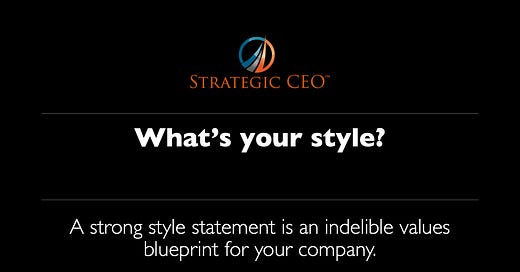What's your style?
A strong style statement is an indelible values blueprint for your company.
THINK ON IT: What’s your style?
What's your style?
I’m not talking about fashion. Or even your leadership style.
I’m talking about your cultural style — the way your employees interact with each other and with your customers. Your cultural style reflects your most resilient values.
You may have identified values you want your company to embrace — those attributes and behaviors that reinforce the reputation you want for your firm. Too often, however, they are easily forgotten.
That’s because they miss the most important ingredient: a why? Just having a list of words like honesty, integrity, innovation, (and so on) don’t tell the why because there’s no story to them.
So, why not create one?
Years ago, several employees of Cray Research, the namesake of genius supercomputer designer Seymour Cray, crafted a style statement to capture the culture of openness and innovation. Studied in business schools across the country, the "Cray Style" was an elegant statement of the interpersonal aspirations of their culture.
"At Cray Research, we take what we do very seriously, but we don't take ourselves too seriously," it began. The statement went on to describe the pride and trust that exists among the employees and the openness between them. The Cray Style served as both a reminder of shared values and as a blueprint for future generations of leaders. (Read the full text). A similar style statement was crafted at Hewlett-Packard. (Read the HP Way).
Why not take a few minutes to outline some of the most important values you want your employees to share? Let it incubate to capture the timeless attributes most important to you. Then share it with your team and see what they add. Challenge them to put it into a story form; to create a style statement, or company way, or manifesto, or whatever you want to call it.
Remember, authenticity is key. If your company’s written style statement is not grounded in reality, it’s going to foster friction or ridicule instead of buy-in.
That’s why this is one exercise you shouldn’t rush. Let it incubate and become something that’s inspiring to your team. That’s when you’ll know you’ve anchored the true values of the organization into the minds of your people.
If you’re struggling on how to get started, I’ve got a roadmap you can follow below.
"Leave to your opinions their own quiet undisturbed development, which, like all progress, must come from deep within and cannot be pressed or hurried by anything. Everything is gestation and then bringing forth." — Rainer Marie Rilke
Thanks for being a subscriber to Strategic CEO. If you enjoyed this post, please share it with a friend or colleague.
Premium subscribers: Read on for a roadmap to help you develop your style statement.
Not a premium subscriber and want to keep reading? Upgrade to paid here.
Keep reading with a 7-day free trial
Subscribe to Strategic CEO to keep reading this post and get 7 days of free access to the full post archives.



